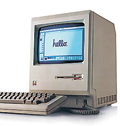Ten best IT products over the past 40 years
Over 40 years, thousands of IT products have appeared - many of them have had a tremendous impact on the professionals of this sphere and they certainly remember. But only a few products really changed the IT and the process of doing the work of IT people and users of various stripes. ComputerWorld has compiled a list of ten IT products that have changed everything!
 IBM System / 370 : In 1964, with its System / 360 mainframe, IBM promised that customers would not have to rewrite their software when they bought the next version of the machine - it would be compatible. It was a revolutionary idea. In 1971, System / 370 confirmed the promise and decided the fate of the competitors of the Aybieme mainframe.
IBM System / 370 : In 1964, with its System / 360 mainframe, IBM promised that customers would not have to rewrite their software when they bought the next version of the machine - it would be compatible. It was a revolutionary idea. In 1971, System / 370 confirmed the promise and decided the fate of the competitors of the Aybieme mainframe.
Ethernet : This technology was developed by Xerox PARC in 1973, and the standard specification came out in 1980. Ethernet won competition from token ring and ARCNET, after which it became the dominant standard for connecting personal computers and servers.
 IBM Personal Computer : In 1981, the first personal computer came out, featuring an open architecture, which allowed users to assemble the computer on their own. Everyone liked it so much that no one would ever give up.
IBM Personal Computer : In 1981, the first personal computer came out, featuring an open architecture, which allowed users to assemble the computer on their own. Everyone liked it so much that no one would ever give up.
 Apple Macintosh : In 1984, Mac showed users the ideal of a friendly computer. The result: a mouse, a graphical interface, hot-plug peripherals, and a fake Microsoft product called Windows.
Apple Macintosh : In 1984, Mac showed users the ideal of a friendly computer. The result: a mouse, a graphical interface, hot-plug peripherals, and a fake Microsoft product called Windows.
')
SAP R / 3 : Remember when the data processing department made its own financial accounting software? Since 1992, SAP AG has eliminated the need to maintain all this code.
Salesforce.com : Software as a service has been very successful. If SAP was offered to buy, instead of doing, then in 1999 Salesforce.com offered to rent.
 Linux : And if Salesforce.com needs to be rented, then Linux is available for free. But more importantly, Linux showed in 1991 that the bulk of the IT infrastructure could be developed by a large group of programmers located in different parts of the world.
Linux : And if Salesforce.com needs to be rented, then Linux is available for free. But more importantly, Linux showed in 1991 that the bulk of the IT infrastructure could be developed by a large group of programmers located in different parts of the world.
Netscape Navigator : This is not the first popular browser - before that was NCSA Mosaic. But when the creator of Mosaic, Mark Andressen, added cookies in 1994, Netscape turned the Network into a global market.
Dynamic RAM : It was invented by IBM, but the first commercial DRAM was sold by Intel in 1970. Within two years, DRAM began to sell better than the magnetic core memory used since the 1950s. And unlike memory on magnetic cores, DRAM obeyed Moore's law: Over time, this will become cheaper and more common.

BlackBerry : The mobile phone allows users to stay in touch, but since 1999, with the BlackBerry phone from Research In Motion, users have received constant access to their e-mail - the era of highly qualified specialists who actively use computer and digital technologies in their work has come.
 IBM System / 370 : In 1964, with its System / 360 mainframe, IBM promised that customers would not have to rewrite their software when they bought the next version of the machine - it would be compatible. It was a revolutionary idea. In 1971, System / 370 confirmed the promise and decided the fate of the competitors of the Aybieme mainframe.
IBM System / 370 : In 1964, with its System / 360 mainframe, IBM promised that customers would not have to rewrite their software when they bought the next version of the machine - it would be compatible. It was a revolutionary idea. In 1971, System / 370 confirmed the promise and decided the fate of the competitors of the Aybieme mainframe.Ethernet : This technology was developed by Xerox PARC in 1973, and the standard specification came out in 1980. Ethernet won competition from token ring and ARCNET, after which it became the dominant standard for connecting personal computers and servers.
 IBM Personal Computer : In 1981, the first personal computer came out, featuring an open architecture, which allowed users to assemble the computer on their own. Everyone liked it so much that no one would ever give up.
IBM Personal Computer : In 1981, the first personal computer came out, featuring an open architecture, which allowed users to assemble the computer on their own. Everyone liked it so much that no one would ever give up. Apple Macintosh : In 1984, Mac showed users the ideal of a friendly computer. The result: a mouse, a graphical interface, hot-plug peripherals, and a fake Microsoft product called Windows.
Apple Macintosh : In 1984, Mac showed users the ideal of a friendly computer. The result: a mouse, a graphical interface, hot-plug peripherals, and a fake Microsoft product called Windows.')
SAP R / 3 : Remember when the data processing department made its own financial accounting software? Since 1992, SAP AG has eliminated the need to maintain all this code.
Salesforce.com : Software as a service has been very successful. If SAP was offered to buy, instead of doing, then in 1999 Salesforce.com offered to rent.
 Linux : And if Salesforce.com needs to be rented, then Linux is available for free. But more importantly, Linux showed in 1991 that the bulk of the IT infrastructure could be developed by a large group of programmers located in different parts of the world.
Linux : And if Salesforce.com needs to be rented, then Linux is available for free. But more importantly, Linux showed in 1991 that the bulk of the IT infrastructure could be developed by a large group of programmers located in different parts of the world.Netscape Navigator : This is not the first popular browser - before that was NCSA Mosaic. But when the creator of Mosaic, Mark Andressen, added cookies in 1994, Netscape turned the Network into a global market.
Dynamic RAM : It was invented by IBM, but the first commercial DRAM was sold by Intel in 1970. Within two years, DRAM began to sell better than the magnetic core memory used since the 1950s. And unlike memory on magnetic cores, DRAM obeyed Moore's law: Over time, this will become cheaper and more common.

BlackBerry : The mobile phone allows users to stay in touch, but since 1999, with the BlackBerry phone from Research In Motion, users have received constant access to their e-mail - the era of highly qualified specialists who actively use computer and digital technologies in their work has come.
Source: https://habr.com/ru/post/12054/
All Articles